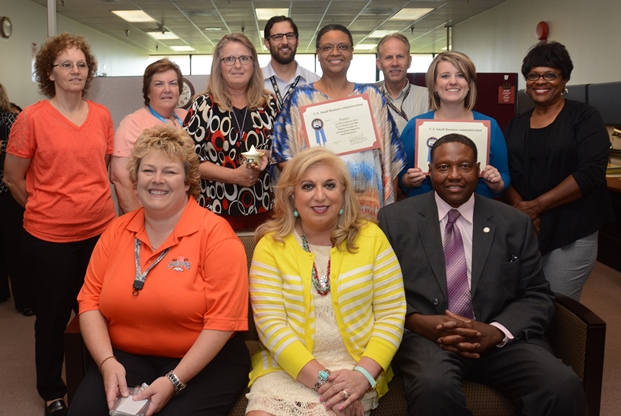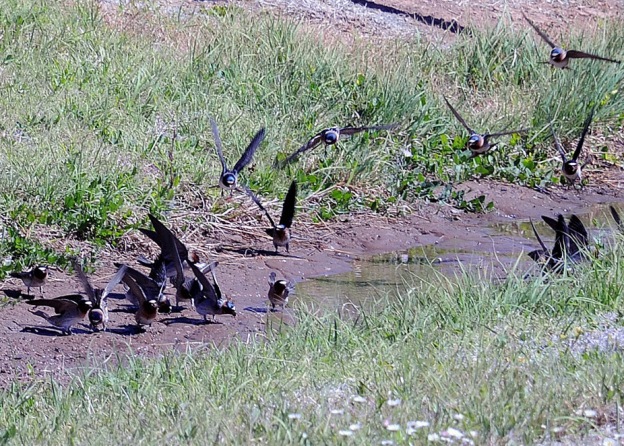Pantex Blog
SBA recognizes Pantex as a leader
The Pantex Plant’s Supply Chain Management organization recently received three awards from the Small Business Administration.
Pantex received the following awards:
- SBA leader in the Lubbock-West Texas District and the SBA Region VI (comprised of Texas, New Mexico, Oklahoma, Arkansas and Louisiana),
- Provider of outstanding stellar access to procurement opportunities for small businesses and
- SBA Procurement All Star.
The awards were presented by SBA Region VI District Director Calvin Davis and Regional Administrator Yolanda Garcia Olivarez.
Pantex has a long history of working with small business. Kelly Delgado-Goudschaal, acting manager of Supply Chain Management said, “These awards are a direct reflection of the dedication and the commitment of the Procurement personnel at Pantex. We have had a long-standing tradition of supporting small businesses within our community. We also work with the West Texas Procurement Center to develop and mentor small businesses within our community.”
Achieving the subcontracting goal is part of the plan. “We have an established goal each year as to the amount of dollars to be awarded to small businesses, and we work with a variety of organizations, such as those with expertise in special tooling, packaging and fuels,” according to Compliance team lead Barbara Smith. Consolidated Nuclear Security, LLC has a small business subcontracting goal of 65 percent for the plant.
Smith added, “It is an honor to be recognized by SBA as a leader for promoting small businesses. For the past seven years, we have consistently exceeded our small business goal. Pantexans continue to support SBA initiatives by identifying small businesses with which we can contract.”

Small Business Administration Region VI SBA District Director Calvin Davis and Regional Administrator Yolanda Garcia Olivarez recently presented awards to Pantex’s Supply Chain Management organization. Featured in photo, front row, from left, Kelly Delgado-Goudschaal, Olivarez and Davis. Back row from left, Frances Tillery, Barbara Smith, Teresa Albus, Jeff Gillmore, Tammi Pedro, Randy Lucas, Ashley Hayton and Diane Johnson.
CNS and Metal Trades Council reach new labor agreement
Consolidated Nuclear Security (CNS) was informed by the Metal Trades Council (MTC) that a new four-year labor agreement has been ratified for work at the Pantex Plant. CNS is appreciative that the negotiations and work stoppage are resolved, and Pantex looks forward to all employees represented by MTC returning to work on October 5, 2015.
Reminders for employees returning to work October 5:
- Pantex managers and supervisors will be contacting employees represented by the MTC with instructions on where to report.
- The Pantex Plant is open for normal operations. All personnel are to report for duty according to their regularly assigned schedules.
- Continue to exercise caution as you approach the Plant and slow down to prevent accidents or injuries.
- Safety and security remain top priority. All security and medical reporting requirements remain in place. Also, please remember not to bring Personal Electronic Devices into prohibited areas.
CNS supports women in STEM luncheon
Since the 1940s when they traded in their aprons for coveralls and gas masks, women have played a key role at the Pantex Plant. To honor their past contributions and celebrate the work they currently perform, Consolidated Nuclear Security, LLC was a corporate sponsor of the recent 2015 Louise Daniel Women’s History Luncheon and Women’s Equality Day Celebration.
The sponsorship was fitting because this year’s event highlighted the work done by women in science, technology, engineering and math (STEM) fields.
Natalie Waters, a Pantex industrial engineer, spoke about the history of local women in STEM and presented a vignette about female STEM professionals at Pantex.
“Young girls and women who live in the Panhandle today should be proud of the women pioneers who worked hard, paved the way and excelled in their STEM fields,” said Waters.
The annual event is named for Louise Daniel, a local science teacher and civic volunteer. Before her death in 2003, Daniel requested that her friends create an event to remind women of all ages about women’s historic struggles to achieve equality.
Six years ago, her friends honored this last wish by creating a women’s history lecture fund at the Amarillo College Foundation. They host a lecture and luncheon in August to coincide with Women’s Equality Day, focusing on a different facet of women’s history each year.

Pantex industrial engineer Natalie Waters, Ph.D., was a keynote speaker at the Louise Daniel Women’s History Luncheon. Pantex scientists and engineers attending the event included (from left) Rachel Ehler, Hannah Pemberton, Isela Galan, Erin Robinson, Raquel Barrera-Chavez, Halianne Crawford, Waters, Brandy Ramirez, Meagan Brown, Courtney Waddell, Karishma Myers, Jessie Phifer, Zelda Martinez and Ava Azores.
The people behind HEPF: Mitch Carry

Mitch Carry, startup manager, of the High Explosives Pressing Facility, has been a part of the project since it began.
The plan to improve the current process for manufacturing high explosives at the Pantex Plant has been in the works since 2002. The current facilities date back to the 1960s, and the equipment involved in pressing is aging and nearing the end of its service life. The current high explosive pressing process occurs in multiple facilities across the plant. The completion of the High Explosives Pressing Facility consolidates all of these processes in one building.
Mitch Carry, startup manager, has been a part of the HEPF since the project began. Carry’s role is to make sure all the required work is completed to guarantee compliance with the appropriate contract requirements for startup and safe operations. This role requires that he have a broad understanding of plant requirements and their associated regulations. It also requires that he work closely with many of the plant organizations to get the work accomplished. When there are problems, he is responsible for working with the right people to resolve the issues.
A major component in guaranteeing compliance is compiling the “objective evidence” or documentation showing that all products satisfy the requirements and prove that the facility is constructed according to strict specifications.
“We have to have documentation for all aspects of the construction,” Carry said. “For example, when you’re placing concrete, you have to be able to prove you installed the rebar correctly, properly mixed and placed the concrete, and then successfully tested the strength of the concrete in accordance with the requirements.” Proving the work was done correctly is no small feat, considering the new facility has about 8,000 yards of concrete, delivered at an average of 9 yards per truck and installed in more than 55 separate placements. “Assembling the records for each placement creates a pedigree for the final product,” he said.
The newly constructed High Explosives Pressing Facility at Pantex will consolidate and improve operations.
Whether it’s the concrete, fire extinguishers, blast doors or even the HE presses, the documents and reports that go with each item are important, and Pantex must be able to produce documentation showing that all aspects of the facility operate safely.
“The basic function of the documentation is to ensure that the facility operates safely and as designed,” said David Crump, director of Pantex Projects Management.
Being able to show that the facility is up to current NNSA regulations is a pivotal step when it comes to getting the facility ready to be occupied, and Carry’s role ensures that part of the process goes as smoothly as possible.
“He has to make sure that all of the facility and the construction and installation documentation that goes with it are available for review by the startup team,” Crump said. “Mitch is a very important to the success of the HEPF and making sure we are ready to go through the readiness process.”
Hope Wallace, project manager, collaborates with Carry by supporting the work involved in the startup process. “Mitch takes a very active role as the startup manager.” Wallace said. “He has to assemble the entire team, and he knows that it takes the whole team to get the project finished.” Even with a project of this scale, great leaders know the importance of keeping up the morale. Carry makes a point to do his best to minimize the stress levels.
“With such a long and important project, there is a lot of pressure placed on everyone, but Mitch knows that you still have to be able to have fun, and your work has to be enjoyable. He does a great job of taking off some of that pressure and it helps the team to keep moving forward,” Wallace said.
While the startup effort on a project this size is daunting, the end result will be a state-of-the-art facility unlike any other. Not only will the new HEPF replace the current, outdated facilities, it will also allow employees to work in an environment designed specifically for this type of work.
“This facility was designed and built for high explosives processing. The whole facility is compliant with all current high explosive processing regulations required by NNSA,” said Carry.
Carry emphasized that one of the most important aspects of the HEPF is how streamlined it will make the process of pressing high explosives, which, in turn, allows for higher production.
“We are looking at our key performance parameters effectively tripling production.” Not only does the new facility allow for greater production, having everything housed in one area will decrease the amount of time Transportation has to spend moving the high explosives. This will help cut down their workload and allow Transportation to focus on other activities, Carry said.
With all of the state-of-the-art equipment and consideration that went into the design of the HEPF, Carry said that the real reason this facility will be so successful is the people who have been involved in the entire process. “There are a lot of good people working on this project, and they know the importance of making it successful. They are the reason for this facility’s success.”
Wild Pantex – Bird of the Day: The Cliff Swallow
Article by Jim Ray, Pantex Wildlife Biologist/Scientist
I have had only one post covering the topic of Bird of the Day since I began writing Wild Pantex blogs back in early 2013 (American Bald Eagle). A timely candidate for the second is the Cliff Swallow which began arriving in our area during the last days of April. Along with its scissor-tail-adorned cousin, the Barn Swallow, the Cliff Swallow is the reason that we are applying sky blue paint on the eaves of specific buildings around the facility.
The Cliff Swallow has a dark chestnut and blackish throat, and a pale forehead. However, its square tail, buffy-colored rump, colonial nesting habitat and gourd-shaped nest easily differentiate it from the Barn Swallow. Formerly, this species was confined largely to overhangs on cliff faces, but now the bird is also adapted to nest on the sides of buildings and under bridges and other protective “canopies”. Its nest is comprised of pellets of mud, but access to the nest is limited to a small entrance hole and short tunnel. The nest interior is lined with grass, feathers and hair, and contains two to six eggs at a time. Normally, only one brood is raised per year, rarely two. A colony of these birds may number in the hundreds, with nests crowded against each other.

Cliff Swallows gathering mud to build their nests.
There is a little bit of a love-hate view of the Cliff Swallow right now. Some hate that this colonial bird often chooses to nest on buildings, but more importantly, the colony often is started over windows, doors and walkways. They are also quite messy during nest building as mud can splatter and towards the end of the nesting period because the young have grown into such “consumers”, that waste cannot be hauled away fast enough by the parents. However, both of those are periods of short durations. The bird, its nests, and its eggs are all protected by the Migratory Bird Treaty Act. In fact, as a colonial bird all nests of the colony are protected from the time the first egg is laid in the colony and lasting until the site no longer is being visited by the swallows (Empty Nest Policy’ of the U. S. Fish and Wildlife Service).
While there are practices that are effective in preventing swallows from nesting at a location, each site needs to be evaluated carefully. After all, the next location that they move to may impact people much more, thus making previous locations appear to have been a more acceptable place for the birds considering impacts to people and the bird’s relatively short nesting season.
The love for the bird comes from our familiarity with the bird as the “swallow of Capistrano” and for its penchant for consuming flying insects. The architecture of its nests and the fact that each consists of 900 – 1,200 individual mud pellets intrigues people, as does the fact that its annual travels take it to and from a wintering area that includes from Panama to northern Argentina. Our Wild Pantex Bird of the Day has completed the portion of its annual nesting cycle and individuals are departing on their annual trek to winter in the western two-thirds of northern South America. Pantex will miss the beneficial and intriguing Cliff Swallow.

Cliff Swallow nests under different stages of construction at Pantex.
